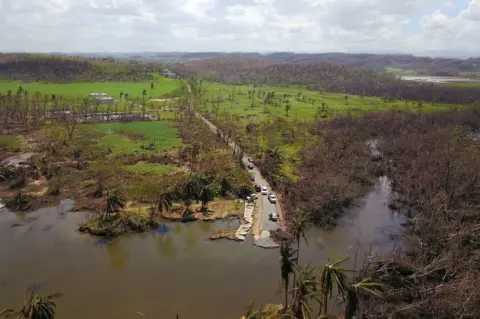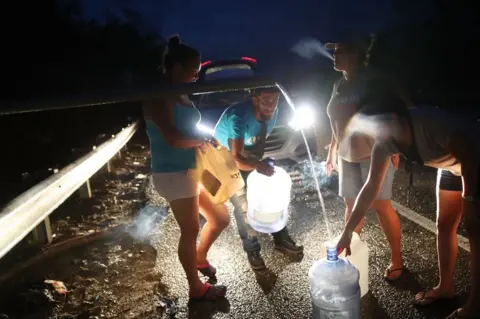Six graphics that sum up Puerto Rico disaster
 Getty Images
Getty ImagesThe island of Puerto Rico was devastated by the worst hurricane in its history over three weeks ago.
Parts of the Caribbean island - home to 3.4 million US citizens - remain isolated, and phone networks have been catastrophically ruined, making it difficult to confirm the picture on the ground.
US President Donald Trump, who visited the island two weeks after Hurricane Maria hit, has pledged a quick recovery but experts say it could take months to complete.
Meanwhile - three weeks after the disaster - only about 10% of Puerto Ricans have electricity and many are fleeing for the mainland United States.
 BBC
BBCWhat does Puerto Rico's recovery look like three weeks after Maria?

Part of the reason Puerto Rico's recovery has been slowed is the island's reliance on air and sea ports to bring fuel, water and food. Runways needed to be cleared of debris and supplies were stuck in the island's ports because of a US law that limits shipping between parts of the US to US-flagged vessels.
Puerto Rico pressed the US to lift the act, and President Trump waived the act for 10 days to help with the recovery.
Mr Trump has also blamed local truck drivers for not getting back to work delivering supplies more quickly.

Among the most lingering dangers of the hurricane is the lack of clean water on the island, which has forced residents to gather from natural springs and ponds wherever possible.
Public health experts worry that this problem will make the recovery even more deadly as sanitary conditions worsen.
The USNS Comfort hospital ship, which arrived on 3 October, came bearing 500 medical personnel and 250 hospital beds onboard.
 Getty Images
Getty Images
While agriculture is no longer a primary driver of Puerto Rico's economy, the destruction of the vast majority of crops on the island means growers in the coffee, plantains and other popular agricultural industries have lost their entire livelihoods in a single storm.
Loss of crops also means Puerto Ricans will need to import more of their food, an effort made more complicated by the nearby exporting countries in the Caribbean who have also been hit by hurricanes.

The storm knocked much of Puerto's Rico communications infrastructure, splitting a crucial link between family members that live in the continental US and on the island, as well as mobile phone networks that could be used to organise the recovery response.
Rebuilding the mobile phone network is expected to take many months.

Residents of Puerto Rico are American citizens, although they have no voting representative in Congress and cannot send electors to vote in US presidential races.
Only about half of mainland Americans in a recent poll know Puerto Ricans are fellow Americans. In a survey, knowledge of their citizenship meant respondents were slightly more likely to support relief aid.
